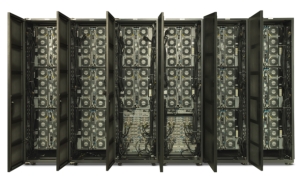Hitachi launches top-end storage array

Hitachi Data Systems has introduced Hitachi Virtual Storage Platform, a storage array with a heavy focus on virtualisation that takes over from Universal Storage Platform V as the company's top-of-the-line enterprise product.
The Virtual Storage Platform (VSP), launched on Monday, builds on the Universal Storage Platform V by adding storage capacity, an Intel Xeon chipset, and a unified management console. Unlike its predecessor, which was sized to fit proprietary Hitachi Data Systems (HDS) racks, it fits standard 19-inch racks. It also allows customers to mix and map storage across three different types of drive: solid-state drive (SSD), Sata and SAS.

The Virtual Storage Platform comes in one to six cabinet configurations. Photo credit: Hitachi Data Systems
The updates have made the VSP "a management piece", Michael Vath, general manager for HDS for Europe, the Middle East and Asia, told ZDNet UK. He picked out the core updates — to Dynamic Tiering and Hitachi Command Suite — as key to the product launch.
"For positioning, this system is more modular than systems before, and with this we are targeting the [larger] enterprise," Vath said. HDS is aiming the storage array at companies that need to be able to scale storage quickly for virtualised or cloud environments.
Dynamic Tiering now allows the VSP to dynamically switch data in 48MB chunks across the different types of drives to match the response time required by the administrator. It sets SSDs as tier zero, SASes as tier one and Satas as tier two. Bob Plumridge, HDS's director of technical marketing, said in a press briefing that Dynamic Tiering means administrators should not have to manually distribute data across different tiers ever again.
The update on Monday to the two-year-old Hitachi Storage Command Suite drops the 'Storage' its name. The storage-management tool provides a single console for administrators to manage physical, virtualised and interlinked-cabinet storage systems.
Hardware-wise, the VSP contains between two and eight blade-based Intel-powered Virtual Storage Directors (VSDs), which help to run the virtualised components of the system. The VSDs can share a terabyte of global cache (1,024GB) to speed the system.
Storage limits depend upon the number, type and proportion of different drives. The system can scale between one and six 19-inch rack cabinets. It can hold a maximum of 2,048 SAS high-density 2.5-inch drives for 1.2 petabytes of capacity, or 1,280 3.5-inch Sata drives for a maximum capacity of 2.5 petabytes.
It can only hold a maximum of 256 solid-state drives, because any more than this and the system bus would reach its limits, Plumridge told ZDNet UK. A fully-scaled system can act as an administrator and manager of up to 255 petabytes of storage capacity, with the majority of this capacity stored externally or in virtualised form.
HDS's mantra for the product is "scale up, scale out and scale deep" — what it calls '3D scaling'. 'Scale up' refers to the storage platform's modular design, which allows administrators to add virtual storage directors, ports, cache and storage capacity on an as-needed basis. 'Scale out' refers to the system's ability to link storage chassis together. 'Scale deep' refers to the VSP's ability to plug into and virtualise third-party storage arrays — a functionality that its predessor also had.
The launch of the product sees HDS continue a battle for hardware in the datacentre. "My preferred enemy is EMC, IBM and NetApp," Vath said.
The VSP is designed to work with Microsoft's Windows Server 2008 R2 Hyper-V and VMware's vSphere 4.1, as well as with business software from Oracle and SAP. It is available from Monday, with a starting price of $234,000 (£147,734).
HP is a reseller of the VSP and has renamed it the P9500. However, HP's product does not offer customers the ability to use the high-capacity 3.5-inch Sata drives, pitching its storage array instead around ease of deployment in standardised datacentre environments where floorspace is at a premium.